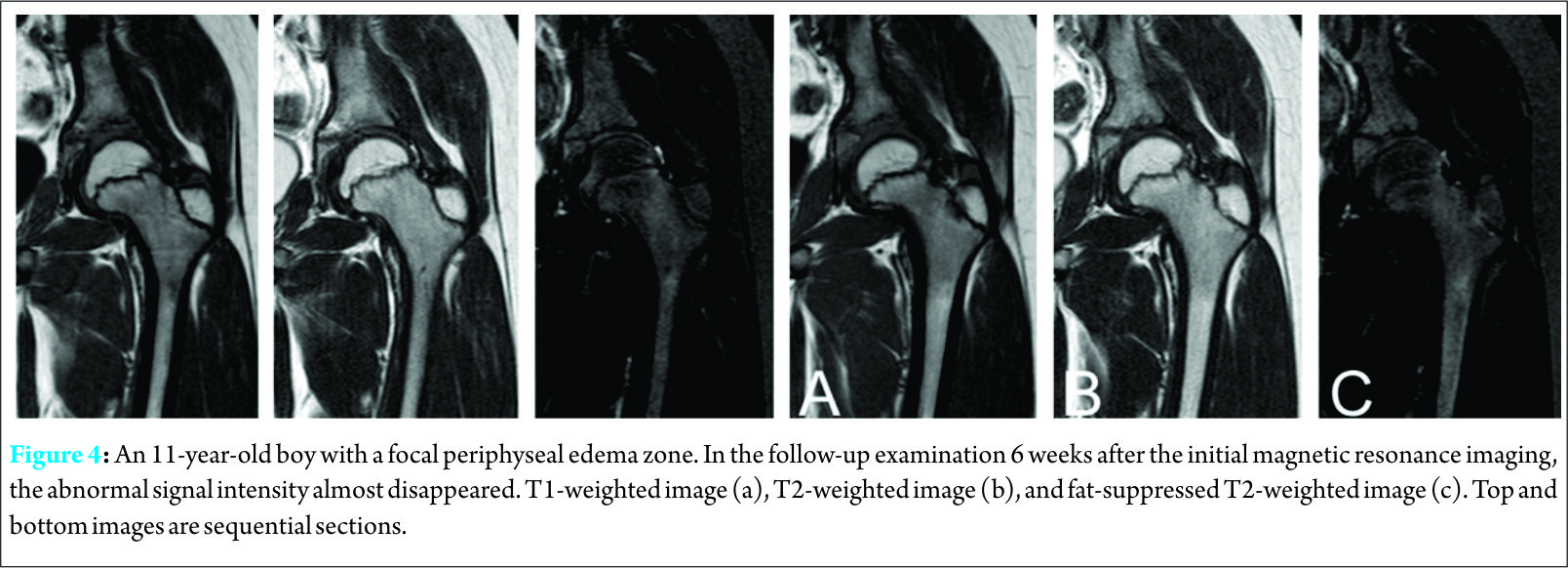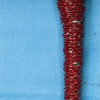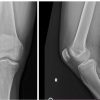[box type=”bio”] What to Learn from this Article?[/box]
Focal periphyseal edema zone on magnetic resonance imaging can occur in a non-weight bearing growth plate of the greater trochanter apophysis.
Case Report | Volume 7 | Issue 4 | JOCR July – August 2017 | Page 29-31| Akio Sakamoto, Shuichi Matsuda. DOI: 10.13107/jocr.2250-0685.836
Authors: Akio Sakamoto[1], Shuichi Matsuda[1]
[1] Department of Orthopaedic Surgery, Graduate School of Medicine, Kyoto University, Shogoin, Kawahara-Cho 54, Sakyo-ku, Kyoto 606-8507, Japan.
Address of Correspondence
Dr. Akio Sakamoto,
Department of Orthopaedic Surgery, Graduate School of Medicine, Kyoto University, Shogoin, Kawahara-cho 54, Sakyo-ku, Kyoto 606-8507, Japan.
E-mail: akiosaka@kuhp.kyoto-u.ac.jp
Abstract
Introduction: Magnetic resonance imaging (MRI) has been used to identify focal bone marrow edema or a focal periphyseal edema (FOPE) zone, in the closing growth plates of adolescent knees.
Case Report: In the current case, an 11-year-old boy reported pain in his left hip. He had been participating in gymnastic classes at school, but otherwise, he was not an active athlete. Based on MRI findings, he was diagnosed with a FOPE zone in his greater trochanteric apophysis. Discontinuity of the cartilaginous growth plate at the FOPE zone was indicative of osseous continuity between the metaphysis and apophysis.
Conclusion: This case suggested that a FOPE zone can occur in a non-weight bearing growth plate and through a tethering mechanism at the initial ossification site during skeletal growth plate maturation.
Keywords: Focal periphyseal edema, hip, greater trochanter apophysis, magnetic resonance imaging.
Introduction
Magnetic resonance imaging (MRI) findings have been used to identify focal bone marrow edema patterns that are centered at the growth plate and extend into the adjacent metaphysis and epiphysis of adolescent knee joints [1, 2, 3]. The lesion has been referred to as a focal periphyseal edema (FOPE) zone [1]. The FOPE zone may be associated with pain, resulting from chronic repetitive microtrauma [1]. In this report, we discuss a case with a FOPE zone in the greater trochanter apophysis.
Case Report
An 11-year-old boy reported pain in his left hip. At the initial evaluation, he appeared normally developed. He was not an active athlete, but he did participate in school gymnastic classes a few hours each week. At the physical evaluation, his hip joint had a full range of motion and was the same bilaterally. Tenderness over the lateral side of the left great trochanter was observed. No particular finding was evident based on the examination of plain radiographs (Fig. 1). The MRI showed bone marrow edema characterized by low signal intensity on a T1-weighted image and a high signal intensity on a fat-suppressed T2-weighted image of the entire left trochanteric area, involving the metaphysis and the apophysis (Fig. 2). The finding was compatible with a reported FOPE zone. Discontinuity of the cartilaginous growth plate was observed, suggesting bony continuity at the FOPE zone. The size of the discontinuous area was 4.5 mm at the growth plate. No abnormal signals were observed on the MRI of the asymptomatic trochanter apophysis on the right side (Fig. 2).
An 11-year-old boy reported pain in his left hip. At the initial evaluation, he appeared normally developed. He was not an active athlete, but he did participate in school gymnastic classes a few hours each week. No particular finding was evident based on the examination of plain radiographs (Fig. 1). The MRI showed the lesion of bone marrow edema was characterized by a low signal intensity on a T1-weighted image, and a high signal intensity was noted on a fat-suppressed T2-weighted image when assessing the entire left trochanteric area, which involved the metaphysis and the apophysis (Fig. 2). The finding was compatible with a reported FOPE zone. Discontinuity of the cartilaginous growth plate was observed, suggesting bony continuity at the FOPE zone. The size of the discontinuous area was 4.5 mm at the growth plate. No abnormal signals were observed on the MRI of the asymptomatic trochanter apophysis on the right side (Fig. 2). The diagnosis of chronic physeal injury was rejected for the current case because chronic physeal injury is characterized by widening of the physis and irregularity of the metaphyseal line [4], which were not seen.
Since there was no traumatic episode in the current case, differential diagnosis included neoplastic and inflammatory lesions. A follow-up MRI examination a week later showed the surrounding marrow edema pattern that was decreased on the T1-weighted image and on the fat-suppressed T2-weighted image (Fig. 3). A follow-up MRI examination 6 weeks after the initial MRI revealed that the abnormal signal intensity had almost completely diminished (Fig. 4). Therefore, the diagnosis of neoplastic lesions could be ruled out. As for infected lesions, osteomyelitis at the epiphysis, or apophyseal infection, was a possibility. However, the pain experienced was mild, and the bone marrow edema seemed not to have substantially manifested. On diagnosing, the possibility of an infection as highly unlikely, a wait, and see strategy was adopted. Blood examination was not performed. In fact, the hip pain had subsided 4 weeks after onset, and the MRI abnormality had improved without any treatment and by the patient abstaining from sport activities, including gymnastics. After ruling out the differential diagnoses of neoplastic and infected lesions, FOPE became the final diagnosis.
Discussion
In a previous report, FOPE zones were reported on knee MRI examinations in a series of 12 patients, comprising 7 girls and 5 boys ranging in age from 11 to 15 years old. The size of the FOPE zone ranged from 2 mm to 27 mm, and all lesions were centrally located at the growth plate [1]. The size of the current lesion was 4.5 mm in diameter and was located at the center of the trochanteric growth plate. These MRI findings, the clinical data, and the age of this patient are similar to those in the previous report, with the exception of the anatomical location. Among the reported 12 FOPE cases of the knee, one case involved the fibula in addition to 2 FOPE lesions, one at the distal femur epiphysis, and another at the proximal fibular apophysis. The proximal fibular apophysis bears less weight than the tibia. The current case in the greater trochanter apophysis is a non-weight bearing example and suggests that a FOPE zone can occur in joints other than the knee [1]. During skeletal maturation of the growth plate, the initial ossification forms a bridge between the metaphysis and epiphysis, beginning at the center of the growth plate and expanding to include the whole growth plate [5, 6, 7]. The FOPE zone has been reported to originate at the initial ossification site [1]. The signal abnormality of a FOPE zone on an MRI may be due to microfractures [8, 9]. The occurrence of pain in the FOPE zone has been assumed to be the same as the tethering mechanism occurring in coalitions in the feet [8]. In support of this mechanism, the current FOPE zone existed in an area of defective cartilaginous tissue at the growth plate, suggesting the formation of a bone bridge at the initial site of ossification. Increased stress is assumed to be the cause of a FOPE zone, based on the data that show three-quarters of FOPE zone, cases were observed in patients who participated in competitive athletic activities [1]. In the current case, the patient was not an athlete, but he did participate in school gymnastic classes. Therefore, the possibility that the FOPE zone and the sporting activity could be related cannot be discounted. As for neoplastic lesions as the differential diagnosis of FOPE zones, bone tumors occur in proximity to the epiphysis or apophysis in children and can include chondroblastoma, chondromyxoid fibroma, and osteoid osteoma, all of which are benign in nature [10]. Osteolytic lesions were not present in the current case; therefore, the lesion was less suggestive of chondroblastoma or chondromyxoid fibroma, whereas osteoid osteoma is a small lesion characterized by surrounding bone marrow edema [11]. However, the characteristic clinical symptoms of night pain for osteoid osteoma were absent in the current case. Malignant bone tumors in children include osteosarcoma and Ewing’s sarcoma, but the epiphysis or apophysis is not known sites for these tumors [10].
Conclusion
In summary, the case of a FOPE zone in the greater trochanter apophysis is reported. The current case supports a mechanism, whereby a FOPE zone occurs at the initial site of ossification at the growth plate, and the pain occurs as a result of a tethering mechanism.
Clinical Message
MRI findings have been used to identify focal bone marrow edema patterns that are centered at the growth plate and extend into the adjacent metaphysis and epiphysis of adolescent knee joints. The lesion has been referred to as a FOPE zone. In this report, the case of a FOPE zone in the greater trochanter apophysis is reported. The current case supports a mechanism that a FOPE zone occurs at the initial site of ossification at the growth plate.
References
1. Zbojniewicz AM, Laor T. Focal periphyseal edema (FOPE) zone on MRI of the adolescent knee: A potentially painful manifestation of physiologic physeal fusion? AJR Am J Roentgenol 2011;197(4):998-1004.1. Zbojniewicz AM, Laor T. Focal periphyseal edema (FOPE) zone on MRI of the adolescent knee: A potentially painful manifestation of physiologic physeal fusion? AJR Am J Roentgenol 2011;197(4):998-1004.
2. Beckmann N, Spence S. Unusual presentations of focal periphyseal edema zones: A report of bilateral symmetric presentation and partial physeal closure. Case Rep Radiol 2015;2015(465018):1-8.
3. Bochmann T, Forrester R, Smith J. Case report: Imaging the clinical course of FOPE-a cause of adolescent knee pain. J Surg Case Rep 2016;11:1-2.
4. Caine D, DiFiori J, Maffulli N. Physeal injuries in children’s and youth sports: Reasons for concern? Br J Sports Med 2006;40(9):749-760.
5. Haines RW. The histology of epiphyseal union in mammals. J Anat 1975;120:1-25.
6. Harcke HT, Synder M, Caro PA, Bowen JR. Growth plate of the normal knee: Evaluation with MR imaging. Radiology 1992;183(1):119-123.
7. Sasaki T, Ishibashi Y, Okamura Y, Toh S, Sasaki T. MRI evaluation of growth plate closure rate and pattern in the normal knee joint. J Knee Surg 2002;15(2):72-76.
8. Kumai T, Takakura Y, Akiyama K, Higashiyama I, Tamai S. Histopathological study of nonosseous tarsal coalition. Foot Ankle Int 1998;19(8):525-531.
9. Kadambande SS, Hariharan K. Multiple osseous tarsal coalitions: A case report and review of the literature. Foot Ankle Int 2003;24(8):653-656.
10. Dorfman HD, Czerniak B. Soft Tissue Tumors. St. Louis: CV Mosby; 1995.
11. Wootton-Gorges SL. MR imaging of primary bone tumors and tumor-like conditions in children. Magn Reson Imaging Clin N Am 2009;17(3):469-487.
 |
 |
| Dr. Akio Sakamoto | Dr. Shuichi Matsuda |
| How to Cite This Article: Sakamoto A, Matsuda S. Focal Periphyseal Edema Zone on Magnetic Resonance Imaging in the Greater Trochanter Apophysis: A Case Report. Journal of Orthopaedic Case Reports 2017 Jul-Aug;7(4):29-31 |
[Full Text HTML] [Full Text PDF] [XML]
[rate_this_page]
Dear Reader, We are very excited about New Features in JOCR. Please do let us know what you think by Clicking on the Sliding “Feedback Form” button on the <<< left of the page or sending a mail to us at editor.jocr@gmail.com




